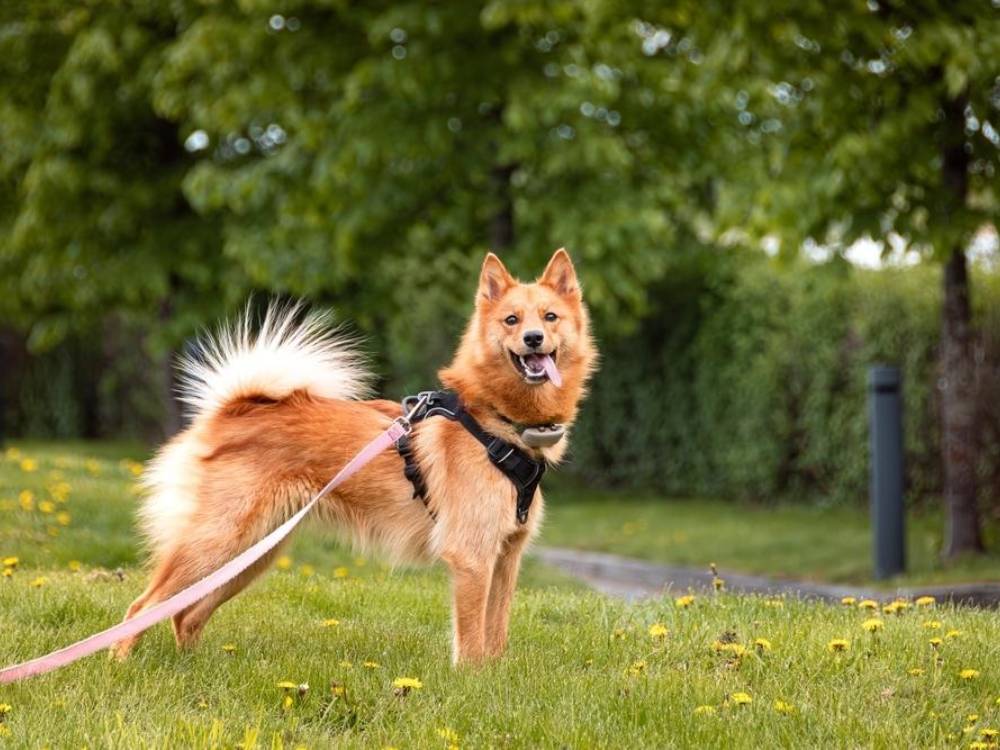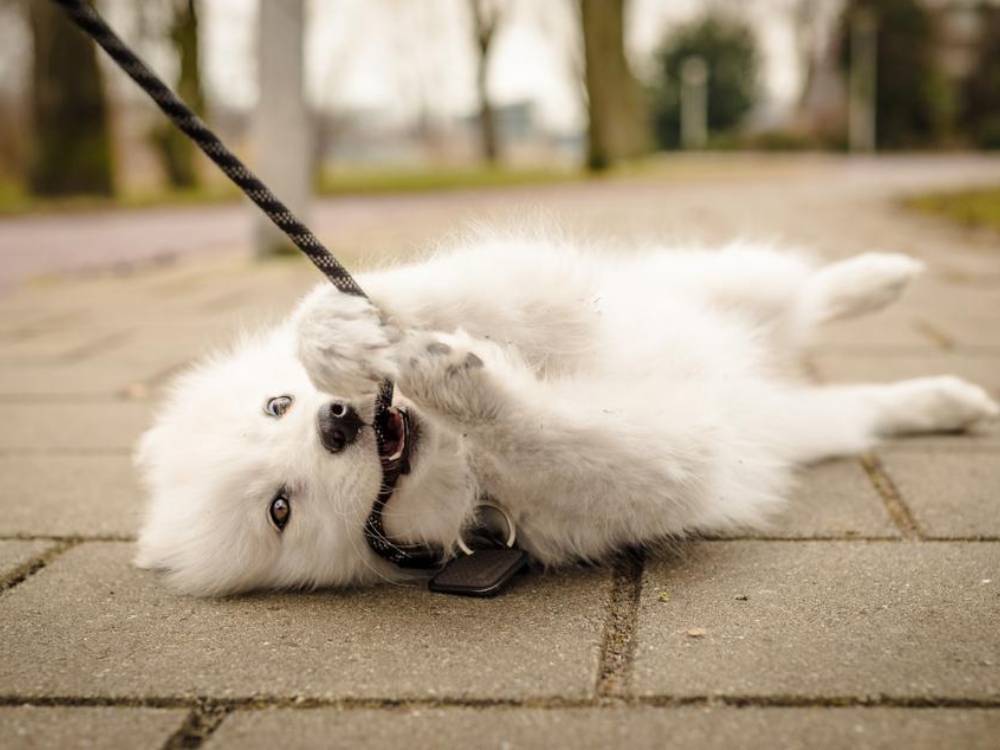

Bringing home a new puppy is an exciting time, but with it comes a lot of hard work. Leash training a puppy is an essential skill to keep them safe when they're outside, but it can often be an intimidating task. Fortunately, with patience, rewards, and good communication, you can help them to enjoy (and even look forward to) being on the leash.
Here's what you should know about leash training a puppy.
Choosing the Right Essentials
Selecting the right leash and collar can make a big difference in your puppy's success. Some breeds do better with specific training tools, and the wrong type can interfere with training or even cause injury to you or your pet. Here are some guidelines to choose the best options when leash training a puppy.
Collars
Collars are often the first tool pet parents purchase for their new pup. And while choosing one that shows off their personality may be fun, it's not the most important feature. The right collar can depend on the breed (and your dog's preferences), but in general, all puppies should learn to wear a collar so they can keep their ID tags on them in emergency situations.
Select a collar that has a buckle or snap closure, and make sure that you check the fit of your puppy's collar every few days. They can grow quickly, and you'll need to purchase a larger collar as they get older.
Avoid Slip and Choke Collars
These types of collars tighten around the puppy's neck if the pup tugs, or you suddenly stop or pull back on the leash. These are not appropriate for puppies or small adult dogs at any time, as they can injure the neck or trachea, potentially causing respiratory issues when used incorrectly. They can also increase barking, pulling, lunging, and anxious behavior in dogs of all ages.
Harnesses
Trainers consider harnesses to be an excellent tool for leash training dogs. They reduce strain on the dog's neck and distribute pressure more evenly, giving you better control during the training process. Small dogs and puppies often prefer harnesses over collars, as well.
If you choose to buy a harness for your puppy, make sure to select a Y-shaped harness, rather than an H-shaped one. The latter features straps that cross over the chest or shoulders, which can impede normal shoulder movement, change the dog's gait and potentially cause injuries.

Leashes
Start with a lightweight nylon leash for puppies. As they grow, you may choose a heavier weight leash or upgrade to a leather leash for better hand comfort. For added control, some leashes feature two handles — one at the end and another closer to the dog. These can offer better handling during training or in busy areas.
When choosing hardware, look for a heavy-duty swivel carabiner that fastens securely to your dog's collar or harness.
As for length, stick to 6 feet for walks, or 4 feet for tall pups.
Avoid Retractable Leashes
Retractable leashes teach your dog to tug and pull. They can also cause severe injury to you or your pet as the narrow cable slips through your fingers or wraps around your or their legs. Lastly, the spring mechanisms can break, causing injuries or a loose dog.
How To Leash Train a Puppy
Patience and understanding are essential parts of leash training your puppy. Just like learning any new skill, it will take time for them to understand what's expected of them. To help with this, make sure you're communicating consistently and being gentle in your corrections.
Once you've chosen your tools, use these steps to train:
1. Let your pup get used to a collar and leash first.
Attach the leash to their collar and let them drag it around the house. Then, pick up the leash and follow them around, without guiding them. Let them learn that there's nothing to fear. Do this once or twice a day for several days, keeping training sessions short, since puppies have a short attention span.
2. Praise good behavior.
When the pup walks alongside you on a loose leash, tell them how smart they are and offer a treat reward. Use the treats as motivation to keep them by your side.
3. Keep the leash loose.
Holding the puppy too tightly to your side encourages pulling and trying to escape. At first, you simply want the puppy to move along with you.
4. Keep the pup on one side.
This helps prevent leash tangling. Remember, though, dog walks are primarily for the dog. Make it fun for your puppy: allow them to enjoy smells and chase a bug or two. When needed, use treats to encourage your puppy to move on after a thorough sniff.
5. Provide time for potty duty.
Pups typically sniff in a circle prior to squatting, so pay attention and reward the pup for going potty outside.
6. Find a comfortable pace.
During training, choose a pace that's easy for you both, so you're not dragging them (and they're not dragging you)!
Leash Training Problems and Tips
Young puppies will likely have several bad habits on walks. But by training them early, you can set them up for a lifetime of enjoyable outside adventures. Here's what to do if your puppy responds to leash training negatively:
Leash Pulling
Puppies instinctively pull in opposition to the leash, whether they're wearing a harness or collar. If your pup pulls, immediately stop and say "oops" or "no pull" and ask them to sit. Wait for a loose leash before continuing forward. This teaches the pup that they can only move when the leash remains loose. Use treats and other positive reinforcement to reward good behavior.
Alternatively, when the puppy begins to pull, turn right in a tight circle, walking the pup around and around. With this method, they learn that forward movement only happens with a loose leash.
"No-pull" harnesses also teach this lesson. These Y-shaped harnesses feature a hook on the front of the harness, instead of the back. When the puppy pulls, it naturally turns them to face you, teaching them that they can only move forward with a loose leash.
Barking at Other Dogs
Puppies bark when excited, especially if they see something new or fun. But barking can also be a sign of fear or anxiety. If your puppy seems more nervous than excited, speak to them in a gentle, soothing tone. Anxious behavior may have the potential to turn into leash aggression, which can be hard to deal with, so it's important to handle it appropriately.
To counter barking, distract the pup with something better, like a favorite toy for them to carry. You can also toss a treat into the grass when you anticipate them getting ready to bark, and ask them to find the reward. This turns the other dog into a cue for good things, so the pup has less inclination to bark.
Leash Biting
Puppies will quickly turn a leash into a tug toy if you let them. This most commonly happens when the leash hooks to the collar or harness and flips around underneath the pup's chin. As with barking, have a squeaky toy or treat handy to redirect the pup to a more positive behavior. Twisting the collar back around so it's more difficult to reach, or attaching the leash to the shoulder hook on the harness often stops the behavior.

Leash Aggression
Leash aggression often results from fear. For example, if they're afraid of other dogs, then they may get aggressive when putting on their leash because they know that they could see other dogs. This type of behavior can be more challenging, and in most cases, you'll need help from a professional behaviorist or trainer. However, these tips may help:
Take along several tasty treats on your walk.
When you see another dog approaching, don't wait for your puppy to react. Immediately point out the other dog and use a high-pitched happy voice to say, "It's a cookie dog!" At the same time, shove a smelly treat right in front of the pup's nose. Keep repeating "cookie dog!" in a happy voice, feeding them treats as long as the other dog remains in sight. When the other dog goes away, so should the treats.
The pup may act confused, continue to growl or act aggressive, but should finally accept the treat.
Continue the singsong phrase and treats whenever you see another dog. That associates the strange dog's presence with good things for your pup. Turn your pup's face toward you, and walk away as you feed treats to give your pup the distance and space to feel safe.
Done with consistency, leash-reactive dogs may eventually eagerly go on walks and look around to find another dog in order to get goodies.
FAQs
How long does it take to leash train a puppy?
Practice with the leash every day, and your pup should walk well within two to three weeks. Some learn very quickly, while others take longer. Teaching the pup to heel (walk immediately beside you with a loose leash) often takes longer — both you and your puppy may benefit from puppy classes to help refine these skills.
When should you leash train a puppy?
Leash training a puppy should begin as soon as you bring the puppy home.
How to manage leash training a puppy who won't walk?
Lure training can help entice reluctant pups to walk on leash. Hook the leash onto their collar or harness and place a toy or treat in front of their nose. Pretend to play with the toy or eat the treats. Your puppy may not move at first, but eventually, they'll be motivated enough to try moving. This teaches them that they can move freely with the leash on.
You've Got This — and So Does Your Pup
Leash training not only keeps your puppy safe — it also opens them up to the world beyond your home. While it may seem challenging now, it won't be long before you sink into a rhythm and spend more time enjoying the outdoors together. With many adventures on the horizon, each walk is a step toward building a confident, connected companion.























